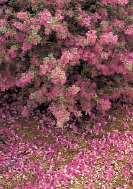
![]() chapter THREE
chapter THREE ![]()
Success with Desert Plants
Agave species
AGAVE
Agaves are also known as century plants. Although most live far less than a century, they do endure for many years, slowly storing energy and getting larger. They finally spend their energy in one massive flowering event. Depending on the species, they grow a single large flower stalk up to 15 to 30 feet high, offering flowers for pollination by hummingbirds, other birds, and bats. After flowering, the plant dies.
Some agaves like to hedge their bets when it comes to reproduction. Before they flower they also produce a number of small offsets called pups around their base. If you prefer, you can select a species that is “solitary” and does not produce pups as readily.
Most agaves have sharp spines on the tips of their leaves. Many also have teeth along the leaf margin. This can make them beautiful to behold but dangerous to be near. Locate them well away from walkways or gathering areas, and allow for their mature size. Unlike a shrub or ground cover, you cannot trim or prune agaves back to suit a small space. You must learn to live with it, or remove it.
Agave americana
century plant


Grayish blue-green leaf blades with spines on tips and margins. With time, grows to 10 feet high and spreads to 15 feet wide—too large for many gardens. Average life span is 20 years. A number of slightly smaller, variegated varieties of A. americana are available. Native to Mexico, but naturalized in mild-winter climates worldwide.
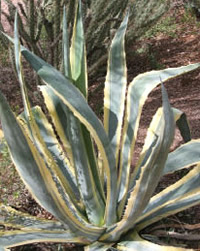
Agave americana marginata, variegated century plant.
Agave americana marginata
variegated century plant


Grayish blue-green leaf blades feature a stripe of yellow down both sides of every leaf. Plant reaches to 10 feet high and 13 feet wide. Because of its large size, locate it carefully. Accepts some shade.
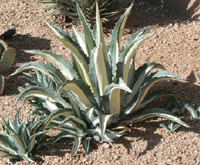
Agave americana mediopicta, mediopicta variegated century plant.
Agave americana mediopicta
mediopicta variegated century plant


Grayish, blue-green leaf blades feature a stripe of yellow down the middle of every leaf, as compared to the leaf margins of A. americana marginata. Plant reaches 4 feet high and 4 feet wide. Accepts some shade.
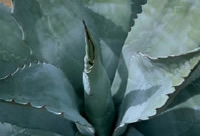
Agave colorata, mescal ceniza.
Agave colorata
mescal ceniza


Broad, blue-gray leaf blades are edged with intricate dark brown teeth that leave embossed patterns on the leaf they were pressed against in the bud. Solitary plants form an angular yet compact rosette 4 feet high and 4 feet wide. Slow to moderate growth rate. Native to Sonora, Mexico.

Agave geminiflora, twin-flowered agave.
Agave geminiflora
twin-flowered agave


Narrow, medium green leaves have sharp tips but toothless edges. Occasionally, the leaves are graced with fine white marginal fibers. Solitary plants reach 3 feet high and 3 feet wide with a moderate to rapid growth rate. Tolerates a range of exposures. In full or reflected sun, the rosettes are tight and compact. Plants in full shade have a more open and relaxed growth habit. Can be grown as a container plant. Native to west-central Mexico.
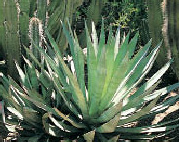
Agave murpheyi, Murphey's agave.
Agave murpheyi
murphey’s agave


Medium wide leaves are bluish to yellow green with spines on the tip and many fine teeth along the edges. Slow to moderate growers, plants reach 3 feet high and 3 feet wide. Pups form readily from the base, but also can be found on the flowering stalk. Accepts some shade. These were once cultivated by native indians in Arizona. Native to Arizona and Sonora, Mexico.
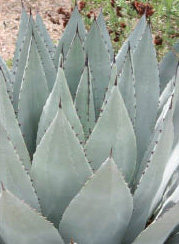
Agave parryi, Parry's agave.
Agave parryi
parry’s agave

Broad, gray-green leaves are edged with brown teeth that leave embossed patterns on the leaf they were pressed against in the bud. Forming compact, nearly round rosettes, individual plants reach 3 feet high and as wide, and can pup readily into large colonies. Native from central Arizona into New Mexico.
Agave victoria-reginae
queen victoria agave

A compact, symmetrical little agave that does fine in containers or in the ground, and takes on quite a regal appearance. It is excellent for smaller spaces, and in filtered light under trees. The short, thick leaves have distinctive white markings and a single spine on the tips. The solitary plants reach 1 to 1 1/2 feet high and as wide. Native to Mexico.
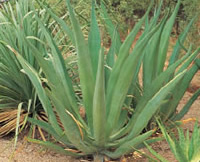
Agave vilmoriniana, octopus agave.
Agave vilmoriniana
octopus agave

Light green, fleshy, and unarmed, the leaves of the octopus agave elongate and curve back, arching with age, until the plant does look remarkably like a large green octopus. The solitary plants reach 4 feet high and spread to 6 feet wide with a slow to moderate growth rate. They flower when they are around a decade old. They do not pup from the base, but can easily be grown from pups called bulbils that appear on the flowering stalk. Native to west-central Mexico.
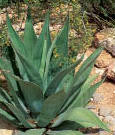
Agave weberi, Weber's agave.
Agave weberi
weber’s agave

One of the largest agaves, it makes a dramatic accent with broad, blue-green leaves that form a neater rosette than Agave americana. Leaf edges have many fine teeth. Individual plants reach 5 feet high and 5 feet wide with a slow to moderate growth rate. Needs occasional watering to look its best. Accepts some shade. Occasionally produces pups. Native to east central Mexico.
Aloe species
ALOE
Aloes are highly variable in form, size, color and texture. Some species make dramatic accents, such as Aloe ferox, while others, including Aloe vera and Aloe variegata, look their best massed in large beds. Many do well in containers. Once they are mature, they flower every year with long stalks of flowers pollinated by hummingbirds. Not all aloes are medicinal such as Aloe vera—some are used to make poison darts! Aloe mite can be a problem with some species. All aloes are native to Africa.
Aloe arborescens
tree aloe


Thick, fleshy leaves are usually gray-green although they can vary with subspecies; some are sea green to lime green. Leaves are 2 inches wide and 2 feet long with regular gray teeth along the margins. Growth is upright and bases become woody. In their native South Africa, ancient plants reach 3 to 14 feet high, topped in winter with tall spikes of red flowers.
Aloe dawei
dawe’s aloe

This is a dramatic aloe for winter color, with tall, branched spikes of fiery, orange-red tubular flowers December through February. Hummingbirds adore the flowers rich in nectar. Long, narrow, bright green leaves are edged with small teeth, forming an almost shrublike cluster to 3 feet high and as wide. Does best with afternoon shade and water every two to three weeks in summer. Native to Uganda.
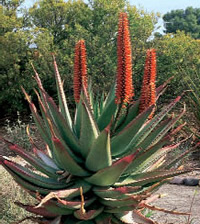
Aloe ferox, cape aloe.
Aloe ferox
cape aloe

A slow-growing, solitary aloe that eventually becomes treelike to 12 feet high and 5 feet wide. Thick, wide, bluish green leaves are edged with russet-colored teeth. Hummingbirds love the flaming orange-red flowers that appear clustered on a tall stalk from late winter into spring. Locate where plants will receive afternoon shade and water once a month in summer for best appearance. Native to the South African Cape.
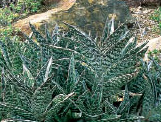
Aloe variegata, partridge breast aloe.
Aloe variegata
partridge breast aloe


This small aloe likes the protected understory environment beneath canopy trees or shrubs. It reaches 1 foot high and as wide with gray-green, triangular leaves decorated with white markings. Plants slowly form clumping colonies that produce spikes of coral-pink flowers in spring and again in fall, attracting hummingbirds. Provide protection from the afternoon sun. Excellent in a rock garden or mixed in with spring wildflowers. Native to South Africa.
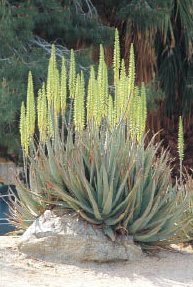
Aloe vera, aloe vera.
Aloe vera
aloe vera, true aloe

(A. barbadensis). Long, slender, gray-green leaves unmarked by any spots combined with yellow flowers lets you know this is the true medicinal aloe. Grows to 3 feet high, spreading to 3 feet wide. Flowers bloom late winter and into spring, appearing on spikes up to 2 feet high above the plant. Accepts full sun to part shade; provide supplemental water in summer to those plants located in full sun. Native to Mesopotamia, and traded throughout Africa, Asia and Europe.
Asclepias linearis
threadleaf milkweed

A bright green, fine-textured plant that can be used as an accent or backdrop in a water-efficient landscape. Soft, fine, threadlike leaves are held rigidly out from the multiple stems that form a shrublike clump to 3 feet high and as wide. Clusters of small white flowers appear on branch ends from spring into fall, and are a favorite of both queen and monarch butterflies. Native to southern Arizona.
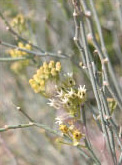
Asclepias subulata, desert milkweed.
Asclepias subulata
desert milkweed

Grows to 4 feet high with slender, gray-green stems. Pale yellow, flat-topped flowers bloom in clusters from spring into fall. Seed pods to 3 inches long split and send out silvery seed fluffs. Great accent around rock-studded drainage swales or courtyards. Good soil drainage required. Attracts queen and monarch butterflies, especially if they are planted in a mass. Native to the Sonoran Desert.
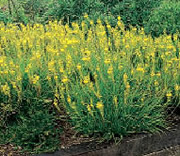
Bulbine frutescens, bulbine.
Bulbine frutescens
bulbine

Long stalks of delicate yellow or orange flowers appear in spring, forming clumps to 18 inches high. Leaves of orange-flowering forms are more gray-green and are more tolerant of full sun. Leaves of yellow-flowering forms are brighter green and do better with some shade. Both grow best in well-drained soil. Can be grown in containers. Native to South Africa.
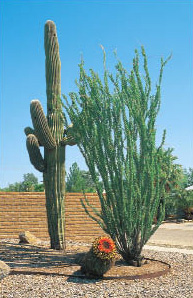
Carnegiea gigantea, saguaro cactus (ocotillo at right).
Carnegiea gigantea
saguaro cactus

This columnar cactus is a well-known symbol of the Southwest. Extremely slow growing 50 to 60 feet high, it towers over the desert landscape. A saguaro may take 30 years to reach 10 feet high and be mature enough to flower. Large, white, bat-pollinated flowers appear wreathlike atop arms in May, followed by edible red fruit. Avoid winter irrigation, but supply monthly water in summer. Requires good soil drainage. Young plants can freeze at 30°F. In nature, they survive freezes and intense summer heat by growing under a “nurse tree.” Native to Sonoran Desert.
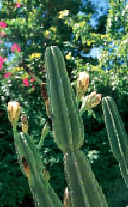
Cereus hildmannianus, Hildmann's cereus.
Cereus hildmannianus
hildmann’s cereus

A fast-growing, columnar, clumping cactus. Each column is up to 10 feet tall and 6 to 8 inches around. However, the entire plant can spread to 10 feet wide. During summer, large, showy white flowers open at night and fade by the next morning. A large, luscious, watermelon-flavored fruit follows the flowers, if they have been pollinated. Accepts some shade. Native to eastern South America.
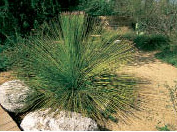
Dasylirion longissimum, grass tree.
Dasylirion longissimum
grass tree

(Dasylirion quadrangulatum). Dramatic, tropical-looking accent plant that eventually can reach over 10 feet high, topped with a whorl of long, slender, dark green, grasslike leaves. Although it only needs 8 to 10 inches of rainfall per year, it will tolerate more water, so it can be combined with other, more lush, tropical plants for great effect. Also accepts shade to part shade exposures. Native to Mexico.
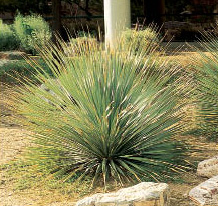
Dasylirion wheeleri, desert spoon.
Dasylirion species
desert spoon, sotol

Both of the following species are quite similar in appearance. They grow slowly, eventually developing a trunk. Mature size is 4 to 6 feet high, spreading to 5 feet wide. Once mature, flower spikes to 12 feet high appear in late fall, but age at which plants actually begin to bloom is unpredictable.
Dasylirion acrotriche, green desert spoon, is almost identical to desert spoon: Its leaves are bright green rather than gray-green. Select this one if you seek a subtropical landscape effect.
Dasylirion wheeleri, desert spoon, has narrow, gray-green leaves that are sharply toothed along the edges. It is highly attractive in a desert setting. Both are native to southern Arizona.
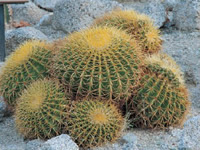
Echinocactus grusonii, golden barrel cactus.
Echinocactus grusonii
golden barrel cactus

One of the best cactus for a bold accent in the landscape due to its symmetrical, globular shape and brilliant, golden spines that light up in the sun. Grows slowly to 3 feet high or more, but remains a manageable size in most gardens for many years. Small yellow flowers appear in spring on the fuzzy crown of mature plants. Plant in sandy, well-drained soil. Water infrequently, perhaps once a month, slightly more often during summer. Native to Chihuahuan Desert.
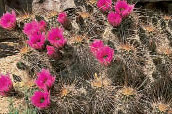
Echinocereus engelmannii, Engelmann's hedgehog.
Echinocereus englemannii
engelmann’s hedgehog

A short, clumping cactus that stops traffic when its large, brilliant, magenta flowers appear in May. A plant may reach 1 foot high to 8 inches across, but clumps can eventually spread several feet wide. Long, gray, downward-pointing spines show bands of red after a rain. Accepts some shade. Native to Sonoran Desert.
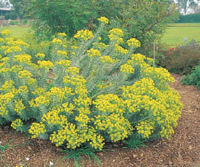
Euphorbia rigida, gopher plant.
Euphorbia rigida
gopher plant

(E. biglandulosa). Unique spring-flowering perennial with blue-gray, textured vertical and spreading branches that grow 2 feet high by 4 feet wide. Flowers on tips of branches are brilliant chrome yellow. Most effective in a sunny spot. Mass in small areas in well-drained soil or plant in containers. After flowers complete bloom cycle, cut back branches to encourage new growth. Native to the Mediterranean.
Ferocactus cylindraceus
compass barrel

(F. acanthodes). At home in natural desert landscapes, this stout, barrel-shaped cactus is a subtle accent in a water-efficient garden. Slow growing to 4 feet high by 1-1/2 feet wide. Plants tend to lean southward with time, giving them their common name. Spines are straight and reddish yellow. Yellow to orange flowers appear in May, followed by fruits with many, tiny, edible seeds inside. Natives would roast and eat the seeds. Avoid overwatering. Native to Sonoran and Mohave Deserts.
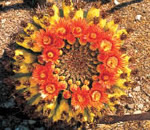
Ferocactus wislizenii, fish-hook barrel cactus.
Ferocactus wislizenii
fish-hook barrel cactus

This cactus looks much like the compass barrel, except the spines are curved in a fish hook shape. And, with time (several decades), it eventually reaches 10 feet high. Spring flowers are yellow to orange, followed by yellow, tart, edible fruit filled with thousands of tiny black seeds. Avoid overwatering or plants may rot and die. Plant in sandy, well-drained soil. Native from Arizona into west Texas and Mexico.
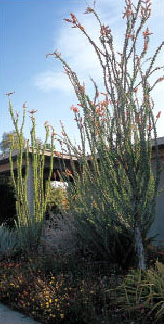
Fouquieria splendens, ocotillo.
Fouquieria splendens
ocotillo

Ocotillo is one of the most distinctive plants of the desert Southwest, and helps provide the Coachella Valley with a definite sense of place. A few to many, unbranched thorny canes, 10 to 15 feet long, arch up out and away from the plant’s base, creating a strong, vase shape. Small, bright green leaves cover the canes during periods of rain and humidity. Leaves drop during dry conditions as plants become dormant. Spikes of flame orange flowers that attract hummingbirds bloom at branch tips during spring. An excellent accent plant, especially when backlit by the sun. Prefers rocky limestone soils. Canes can be cut and used to create living fences. Note that plants grown in containers establish better than bare root plants. Native to southwestern U.S.
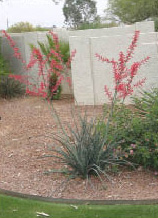
Hesperaloe parviflora, red yucca.
Hesperaloe parviflora
red yucca

This succulent is not a yucca, but in the agave family. It is a workhorse accent plant, flowering tirelessly. Long, slender, swordlike leaves are edged with loose, curling white threads. Plants form clumps to 3 feet high and spread slowly to 5 feet or more. Red yucca is a long-term color provider with tall spikes of coral-pink flowers from late spring into late summer. The bell-shaped flowers are loved by hummingbirds. A variety with pale yellow flowers is also available. Native to Texas.
Hesperaloe funifera, giant hesperaloe, is similar but larger, reaching to 6 feet high and as wide. Leaves are upright, thicker and swordlike. Wide-spreading flower stalks to 10 feet high are topped with greenish white blooms late spring to summer. Native to the Chihuahuan Desert.
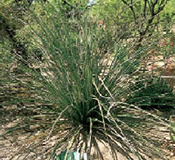
Nolina microcarpa, bear grass.
Nolina microcarpa
bear grass

Narrow, grasslike leaves to 3 feet long form a fountain-shaped mound 3 to 6 feet high, spreading 5 to 8 feet wide. Leaf margins are covered with microscopic teeth. Stems rise 4 to 5 feet above the dense rosette clumps of small, creamy yellow flowers, which are striking in form, not in color. Plants thrive in gravelly, sandy, well-draining soil. Native to southwest U.S.
Opuntia species
PRICKLY PEAR
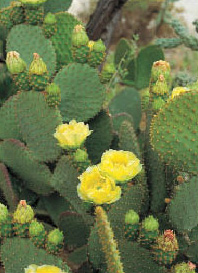
Opuntia species, opuntia.
There are well over 200 varieties of prickly pear. Some have blue-gray pads, some are bright green and others are tinged with violet. Cup-shaped flowers appear in May and bloom in shades of yellow, orange or magenta. All cactus family spines grow out of a cluster called an aureole. Some species lack long spines but have glochids instead. These are like porcupine quills, in that they are barbed to go further in, not out. If you are unfortunate enough to come in contact with these tiny spines, removing them from your skin is difficult. One method seems to work: Coat the area with white glue, let it dry, then peel them away.
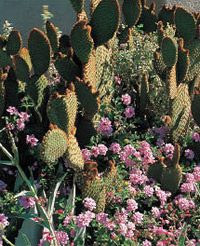
Opuntia basilaris, beavertail prickly pear.
Opuntia basilaris
beavertail prickly pear


Typically blue-gray or deep green pads with aureoles of glochids. (See above.) Brilliant magenta flowers appear in May. Grows to 1 foot high and spreads to 4 feet wide, taking the form and space of a small shrub in the landscape. Native to southwest U.S.
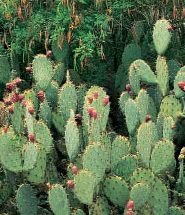
Opuntia engelmannii, Engelmann's prickly pear.
Opuntia engelmannii
engelmann’s prickly pear


Classic green pads with widely spaced, gray-white thorns. Pads are crowned in spring with yellow flowers followed by magenta fruit. Desert tortoises adore the sweet fruit, and people use the fruit to make jelly and candy. Reaches 4 feet high and spreads to 8 feet wide. Takes the form and space of a medium-sized shrub in the landscape. Native to southwest U.S.
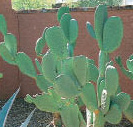
Opuntia ficus-indica, indian fig.
Opuntia ficus-indica
indian fig


The name refers to the edible fruit called “tuna,” which were relished by the ancient Aztecs. This tall, almost tree-like prickly pear reaches up to 15 feet high and as wide. This species is thornless. Cup-shaped yellow to orange flowers are followed by fruit that slowly turn from green to yellow to a purplish red. It is uncertain where this plant originated. It is a horticultural selection discovered and cultivated in tropical and subtropical America.
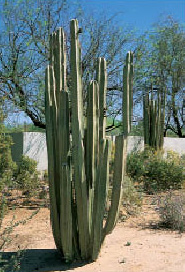
Opuntia species, opuntia.
Pachycereus marginatus
mexican fencepost


This is a fast growing, handsome, dark green, columnar cactus. It can reach 10 feet high and branching from the base can spread to 6 feet wide, although each column is about 6 inches in diameter. The 4 to 6 ribs of each column are decorated with small white spines. Pink flowers appear in spring. Use as a bold, dramatic accent in the ground or in a container. Plant along a wall for spectacular shadows. Extra arms are easy to remove with a pruning saw, and can then be planted directly in a new site. Native to southern Mexico.
Pachypodium lamerei
madagascar palm

This distinctive member of the oleander family has gray bark and a swollen trunk where it stores water. The crown of large leaves on top and paired spines along the stem give it its unique appearance. Slow growing from 10 to 15 feet high, the diameter remains about 2 feet wide. Protect from cold when temperatures drop near freezing. Or, if grown in a container, move to a warmer location when frost threatens. Plant in well-drained soil. Accepts some shade. Native to southern Africa.
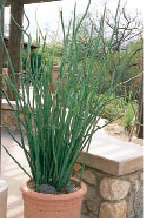
Pedilanthus macrocarpus, slipper flower.
Pedilanthus macrocarpus
slipper flower

A striking succulent that forms a clump of mostly leafless, upright, silvery green stems about the diameter of your index finger. Stems reach 2 to 3 feet high with the clump spreading slowly to 2 feet wide. The striking red “slippers” contain several tiny flowers, plus nectar that hummingbirds seek. They appear in late spring and occasionally summer into fall. Makes a fine container plant. Accepts some shade. Like most succulents, provide good drainage to avoid rot. Native to Baja California.
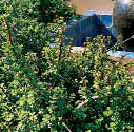
Portulacaria afra, elephant's food.
Portulacaria afra
elephant’s food

This succulent is well adapted to the Coachella Valley. It’s an excellent container plant with an interesting, flowing growth habit that is at home among boulders and native plants. It is often confused with jade plant, Crassula argentea, which it resembles. Elephant’s food grows more rapidly, has more open growth, with limber, tapering branches. Stems are brownish, covered with 1/2-inch, glossy green, succulent leaves. Best with afternoon shade, but too much shade can cause plants to become straggly. Can suffer damage with exposure to intense sun. Native to South Africa.
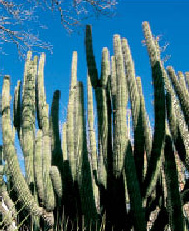
Stenocereus thurberi, organ pipe cactus.
Stenocereus thurberi
organ pipe cactus

A slow-growing golden-green columnar cactus with narrow ribs and aureoles of small reddish brown spines. Individual columns are about 8 inches in diameter, and grow to 10 feet high. Clumps can spread to 10 feet wide with time. Pale pink flowers open at night in late spring. Native to Sonoran Desert.
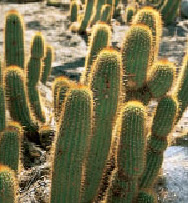
Trichocereus huascha, Argentine hedgehog.
Trichocereus huascha
argentine hedgehog

(Echinopsis huascha). A clumping hedgehog cactus with golden spines covering an olive green body. They glow beautifully when backlit by the sun and can be quite dramatic. Huge glowing red to orange flowers appear in spring, each one lasting only a single day. Accepts some shade. Native to Argentina.
Yucca species
Yucca
Yuccas are generally more cold tolerant than agaves. Indeed, some survive as far north as North Dakota. Yuccas may have spines on leaf tips, but never along the edges, as agaves often do. Yuccas can be solitary or form clumps from the base.
Once mature, yuccas bloom every year with tall stalks of creamy white flowers. Leave the dried stalks on the plant for the favorite nesting place of native bumblebees, or use in dried arrangements. All yuccas are native to the Americas.
Yucca aloifolia
spanish bayonet


Stiff, sharp-tipped, 2-inch leaves are bright green to blue green, and grow 1-1/2 to 2-1/2 feet long. This is a clumping yucca—individual plants reach to 10 feet high and 4 feet across. Clumps may spread to cover 20 feet. An ideal accent for large spaces, but best located well away from pedestrians due to their sharp spines.
Variegated (striped) cultivars are available. Native to southwest U.S.
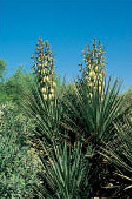
Yucca baccata, banana yucca.
Yucca baccata
banana yucca

(Y. arizonica). Stiff, erect, bluish green leaves are 1 inch wide and 2 feet long. Single plants grow to 3 feet high and to 5 feet across. Forms stemless clumps with 2 to 6 rosettes. The fleshy green to purple, bananalike fruits 4 to 6 inches long are edible. Prefers well-drained soil. Native to southwest U.S.
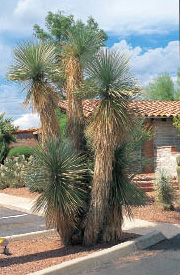
Yucca elata, soaptree yucca.
Yucca elata
soaptree yucca


Refined, deep green leaves are almost grasslike. They are 1/2-inch wide but grow to 4 feet long, with threadlike fibers on the margins. As leaves grow in dense clusters at the tops of the trunk, the dead, golden to brown leaves cling tightly to the trunk, shading the plant. It is slow growing and rarely branches, reaching 6 to 20 feet high and 8 feet wide. Roots contain saponins that can gently clean fine textiles. Native to Arizona and New Mexico.
Yucca gloriosa
spanish dagger

Rosettes of bluish green, stiffly upright leaves are fleshy and grow to 2 feet long and 2 inches wide. This is a clumping yucca that grows at a moderate rate to 10 feet high. Plant base becomes woody with age. Leave the tidy dead leaves in place—they help keep the plant cool. Native to southeastern U.S. from North Carolina into Florida.
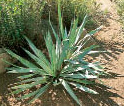
Yucca pallida, pale-leaf yucca.
Yucca pallida
pale-leaf yucca

Pale blue-green leaves are flexible, and measure 1 inch wide by 1 foot long. This unusual yucca has finely serrated leaf margins that can be marked with light yellow to white. A clumping yucca, individuals reach 1 to 2 feet high and spread from 1 to 3 feet wide. With ample water, clumps can get large, with up to 30 rosettes. Native to north central Texas.
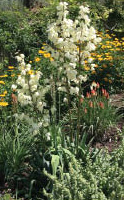
Yucca recurvifolia, pendulous yucca.
Yucca recurvifolia
pendulous yucca

(Y. pendula). Plants grow rapidly to 6 feet high. Dark, gray-green leaves with a bluish cast are 3 feet long and 2 to 3 inches wide. They have soft tips and a relaxed, pendulous nature. Solitary plants grow to 6 feet high and as wide. Trim off dead leaves for best appearance. Accepts shade. Native to southeast U.S.
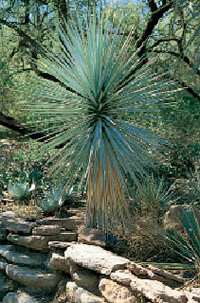
Yucca rigida, blue yucca.
Yucca rigida
blue yucca

Powder blue leaves are stiff and sharp tipped, to 2 feet long and 2 inches wide. The solitary plants reach 12 feet high and spread to 5 feet wide. Older leaves dry and press against the trunk to help conserve water. This thatch should be left in place. Striking coloration and bold form make the blue yucca an outstanding accent plant. Native to northern central highlands of Mexico.
Yucca whipplei
our lord’s candle


Slender, bluish gray-green leaves are 1 1/2 feet long and 3/4 inch wide. They radiate from the base to form an attractive rosette 2 feet high and 3 feet across. Like agaves, this yucca flowers once and dies, but generally a few pups (small plants) around the base insure the plant’s long-term survival in the landscape. Native to California, Arizona and Baja California.